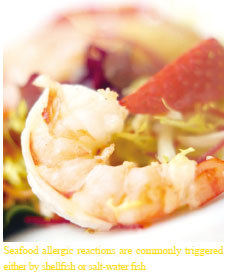Good quality data essential in a global marketplace where industries must manage hazards across complex supply chains spanning continents

HEADLINES like 'Teen with peanut allergy dies after kiss' encapsulate the big problem associated with food allergens. As minimal amounts of food can pose a lethal threat to allergic people, there is a high degree of alertness and uncertainty amongst consumers, food industry and legislators. Food allergies are on the rise - at least, this is what the public assumes and what recent studies suggest. Nobody knows exactly what percentage of the population is affected by an adverse immune response of a food protein. Twelve allergens are responsible for more than 90 per cent of the allergic reactions, with the top food allergens being eggs, milk, peanuts, seafood and soy. Yet scientific evidence is insufficient to establish clear intake thresholds for these ingredients below of which an allergic reaction does not occur. Finding reliable and practicable methods to analyse and determine the allergic potential of a foodstuff is a challenge for both research and regulation. All efforts by science, politics and industry aim to reduce the risks for allergy sufferers. Concerns about food allergies have increased over the last 20 years. In response, the European Commission has funded a series of projects focused on food allergy. In June, the Akademie Fresenius and SGS Institut Fresenius hosted the 4th International Conference on 'Food Allergens' in Frankfurt. Clinical aspects, regulatory and scientific matters, analytical approaches and industry practice formed the core topics of the two-day expert meeting. According to Clare Mills of the Institute of Food Research (UK) there are good reasons for this engagement. "The lack of good quality data on how many people suffer from food allergies, which foods they react to, how much of a food can cause a problem, has been hampering the development of effective strategies to optimise the quality of life for allergic patients. There is also no data on the impact of food allergies on quality of life or an estimate of its cost to society," Dr Mills, who heads allergy research at IFR, told conference participants.

"This is especially relevant in an era of the global marketplace where industries must manage hazards across complex supply chains spanning continents," said Dr Mills, who is also coordinator of EuroPrevall, an EU-funded multidisciplinary integrated project to address these issues. Potential and limits of detection methods As there is no treatment currently available to cure food allergies, patients must follow specific avoidance diets to safeguard against adverse reactions. The hazard for the consumer is the presence of undeclared allergens in packaged foods or "hidden" allergens in restaurant and food service products. Joe Baumert (University of Nebraska-Lincoln, USA) reported that many food companies have adopted allergen control programs (ACPs) to eliminate or vastly reduce the likelihood of undeclared food allergens in packaged foods. Since food allergens are proteins, the most appropriate methods detect protein residues or specific proteins from the allergenic food. RAST (radioallergosorbent tests) rely upon blood serum from humans with food allergies and so cannot be relied upon for routine analysis, but can be very sensitive and specific for allergenic proteins. ELISAs (enzyme-linked immunosorbent assays) are capable of detecting residues of intact proteins from allergenic sources in a sensitive and highly specific manner. Both these analytical methods have limitations. Some food ingredients contain little if any protein from the source but confirming the total absence of protein is essentially impossible. Oils and lecithin may contain very hydrophobic protein residues that are not easily detected by ELIS
JUNIOR HEADLINES like 'Teen with peanut allergy dies after kiss' encapsulate the big problem associated with food allergens. As minimal amounts of food can pose a lethal threat to allergic people, there is a high degree of alertness and uncertainty amongst consumers, food industry and legislators. Food allergies are on the rise - at least, this is what the public assumes and what recent studies suggest. Nobody knows exactly what percentage of the population is affected by an adverse immune response of a food protein. Twelve allergens are responsible for more than 90 per cent of the allergic reactions, with the top food allergens being eggs, milk, peanuts, seafood and soy. Yet scientific evidence is insufficient to establish clear intake thresholds for these ingredients below of which an allergic reaction does not occur. Finding reliable and practicable methods to analyse and determine the allergic potential of a foodstuff is a challenge for both research and regulation. All efforts by science, politics and industry aim to reduce the risks for allergy sufferers. Concerns about food allergies have increased over the last 20 years. In response, the European Commission has funded a series of projects focused on food allergy. In June, the Akademie Fresenius and SGS Institut Fresenius hosted the 4th International Conference on 'Food Allergens' in Frankfurt. Clinical aspects, regulatory and scientific matters, analytical approaches and industry practice formed the core topics of the two-day expert meeting. According to Clare Mills of the Institute of Food Research (UK) there are good reasons for this engagement. "The lack of good quality data on how many people suffer from food allergies, which foods they react to, how much of a food can cause a problem, has been hampering the development of effective strategies to optimise the quality of life for allergic patients. There is also no data on the impact of food allergies on quality of life or an estimate of its cost to society," Dr Mills, who heads allergy research at IFR, told conference participants.
HEADLINES like 'Teen with peanut allergy dies after kiss' encapsulate the big problem associated with food allergens. As minimal amounts of food can pose a lethal threat to allergic people, there is a high degree of alertness and uncertainty amongst consumers, food industry and legislators. Food allergies are on the rise - at least, this is what the public assumes and what recent studies suggest. Nobody knows exactly what percentage of the population is affected by an adverse immune response of a food protein. Twelve allergens are responsible for more than 90 per cent of the allergic reactions, with the top food allergens being eggs, milk, peanuts, seafood and soy. Yet scientific evidence is insufficient to establish clear intake thresholds for these ingredients below of which an allergic reaction does not occur. Finding reliable and practicable methods to analyse and determine the allergic potential of a foodstuff is a challenge for both research and regulation. All efforts by science, politics and industry aim to reduce the risks for allergy sufferers. Concerns about food allergies have increased over the last 20 years. In response, the European Commission has funded a series of projects focused on food allergy. In June, the Akademie Fresenius and SGS Institut Fresenius hosted the 4th International Conference on 'Food Allergens' in Frankfurt. Clinical aspects, regulatory and scientific matters, analytical approaches and industry practice formed the core topics of the two-day expert meeting. According to Clare Mills of the Institute of Food Research (UK) there are good reasons for this engagement. "The lack of good quality data on how many people suffer from food allergies, which foods they react to, how much of a food can cause a problem, has been hampering the development of effective strategies to optimise the quality of life for allergic patients. There is also no data on the impact of food allergies on quality of life or an estimate of its cost to society," Dr Mills, who heads allergy research at IFR, told conference participants.  "This is especially relevant in an era of the global marketplace where industries must manage hazards across complex supply chains spanning continents," said Dr Mills, who is also coordinator of EuroPrevall, an EU-funded multidisciplinary integrated project to address these issues. Potential and limits of detection methods As there is no treatment currently available to cure food allergies, patients must follow specific avoidance diets to safeguard against adverse reactions. The hazard for the consumer is the presence of undeclared allergens in packaged foods or "hidden" allergens in restaurant and food service products. Joe Baumert (University of Nebraska-Lincoln, USA) reported that many food companies have adopted allergen control programs (ACPs) to eliminate or vastly reduce the likelihood of undeclared food allergens in packaged foods. Since food allergens are proteins, the most appropriate methods detect protein residues or specific proteins from the allergenic food. RAST (radioallergosorbent tests) rely upon blood serum from humans with food allergies and so cannot be relied upon for routine analysis, but can be very sensitive and specific for allergenic proteins. ELISAs (enzyme-linked immunosorbent assays) are capable of detecting residues of intact proteins from allergenic sources in a sensitive and highly specific manner. Both these analytical methods have limitations. Some food ingredients contain little if any protein from the source but confirming the total absence of protein is essentially impossible. Oils and lecithin may contain very hydrophobic protein residues that are not easily detected by ELISJUNIOR
"This is especially relevant in an era of the global marketplace where industries must manage hazards across complex supply chains spanning continents," said Dr Mills, who is also coordinator of EuroPrevall, an EU-funded multidisciplinary integrated project to address these issues. Potential and limits of detection methods As there is no treatment currently available to cure food allergies, patients must follow specific avoidance diets to safeguard against adverse reactions. The hazard for the consumer is the presence of undeclared allergens in packaged foods or "hidden" allergens in restaurant and food service products. Joe Baumert (University of Nebraska-Lincoln, USA) reported that many food companies have adopted allergen control programs (ACPs) to eliminate or vastly reduce the likelihood of undeclared food allergens in packaged foods. Since food allergens are proteins, the most appropriate methods detect protein residues or specific proteins from the allergenic food. RAST (radioallergosorbent tests) rely upon blood serum from humans with food allergies and so cannot be relied upon for routine analysis, but can be very sensitive and specific for allergenic proteins. ELISAs (enzyme-linked immunosorbent assays) are capable of detecting residues of intact proteins from allergenic sources in a sensitive and highly specific manner. Both these analytical methods have limitations. Some food ingredients contain little if any protein from the source but confirming the total absence of protein is essentially impossible. Oils and lecithin may contain very hydrophobic protein residues that are not easily detected by ELISJUNIOR
 iConnectHub
iConnectHub
 Login/Register
Login/Register Supplier Login
Supplier Login


























